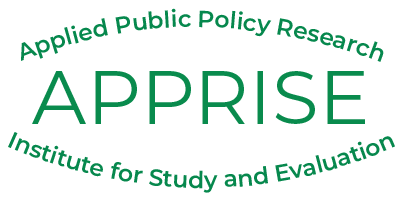RESEARCH AREAS
LOW-INCOME USAGE REDUCTION | BILL PAYMENT ASSISTANCE | RENEWABLE ENERGY PROGRAMS | MARKET TRANSFORMATION
Low-Income Usage Reduction Programs
The federal government, state governments, regulatory bodies, and utility companies manage usage reduction programs that provide home weatherization and energy efficiency services to low-income households. The aim of these programs is to reduce energy usage and increase the affordability of energy bills. APPRISE’s research and evaluation assesses the efficiency and effectiveness of these usage reduction programs. See below for a sampling of APPRISE’s research and evaluation in this research area.

Low-Income Usage Reduction Program Evaluation Activities
Needs Assessment includes analysis of program data, customer data, and publicly available data. These analyses provide information on the number of customers who are eligible for the program, the energy usage of eligible customers, and the potential energy savings from the program.
Technical Assistance includes reviews of program models and research results that may inform program design, development of budgeting and planning spreadsheets, and recommendations for data needed for comprehensive program evaluation.
Process Evaluation includes reviews of program documents, interviews with program staff, observation of service delivery, and inspection of completed services.
Impact Evaluation includes analysis of usage, billing, and payment data to estimate the impact of energy efficiency services on energy usage, energy affordability, and bill coverage rates. Impact analysis utilizes techniques including data attrition analysis, weather normalization, and comparison groups to provide robust assessments of program impacts.
Survey Research includes telephone and mail surveys of program participants and telephone and mail surveys of service delivery staff. The customer surveys assess customer understanding of program services and benefits, barriers to program participation, changes in energy usage behavior, persistence of energy measures, and program satisfaction. Service delivery staff surveys measure contractor understanding of program procedures, adherence to program procedures, and barriers to successful program implementation.
Data Tracking includes analysis of data needed for program management, operations, and evaluation; reviews of existing data systems and how they facilitate the program; and recommendations for data tracking enhancements. Program managers need to understand program accomplishments compared to goals, aggregate program expenditures and expenditures per home, and savings projections compared to goals. Program implementers need to obtain energy usage data on targeted customers and report information on home conditions and services delivered. Evaluators need pre- and post-usage data, home condition data, and information on services delivered.
Non-Energy Impact Analysis includes assessment of the program’s impact on the economy, job opportunities, emissions, community awareness of energy efficiency opportunities, and health and safety.
Performance Measurement includes development and measurement of indices that correspond to program goals and objectives. For example, the indices may include program participation rates for segments of the eligible population, incidence of various measures such as two-for-one refrigerator replacement, percentage of pre-program usage saved, or the savings to investment ratio achieved by the program.
APPRISE Low-Income Usage Reduction Research and Evaluation
Below we provide a few examples of some of our recent low-income energy efficiency program research and evaluation projects. Click the tabs below to learn more about these projects, or see here for a full list of projects in this topic area.
Many low-income usage reduction programs are facing increasing challenges serving customers due to the prevalence of health and safety problems that prevent major measures from being installed. As a result of serious issues in the home, customers must be deferred or are treated with only minor services, and high-usage customers with good potential for savings do not participate or only achieve low energy savings. This research assessed the circumstances under which additional cost-effective health and safety spending can be invested to achieve greater savings for low-income customers and the program as a whole.
Sacramento Municipal Utility District’s (SMUD) Low-Income Weatherization Program provides no-cost energy services to qualified low-income residential customers. The goals of the program are to reduce electric bills, improve safety and comfort, provide energy education to reduce usage and lower bills, and partner with contractors and community organizations in providing these services. APPRISE’s comprehensive evaluation included needs assessment, interviews with program administrators and contractors, a participant survey, on-site inspections of completed jobs, and billing analysis to measure the impacts on energy usage.
APPRISE conducted research for the Environmental Defense Fund to document low-income energy efficiency (LIEE) programs in four states and around the country. The research assessed the state-level policy and program design changes that are necessary to overcome barriers and fully realize the benefits of LIEE. The topics that were explored included the Regulatory and Program Structure of LIEE offerings, Barriers to and Potential for Investment in Low-Income Energy Efficiency, Best Practices for Low-Income Energy Efficiency Programs, and Policies and Financing Mechanisms. The report answered three core questions: 1) How does the current regulatory and program structure of LIEE offerings in each state impact the scale, speed, and efficiency of deployment, 2) What are the specific barriers to deploying LIEE to levels approaching its potential, and 3) What are some of the best practices for LIEE program design, marketing, reporting to expand LIEE in each target state.
The NJ Comfort Partners Program provides no-cost energy efficiency services to low-income utility customers throughout the state. The 2020 evaluation reviewed program changes that were made since the 2017 evaluation, estimated energy savings with a billing analysis, reviewed and recommended changes to the Energy Saving Protocols, and conducted a cost-effectiveness analysis.
PGW’s Home Comfort Program provides no-cost comprehensive weatherization treatments to selected high-usage PGW customers. APPRISE’s annual evaluations estimate energy savings, assess savings achieved by individual contractors and energy efficiency measures, and analyze bill savings. Evaluations have included analysis of client targeting; interviews with program managers and implementation contractors; and review of inspection reports to identify how PGW can improve the program’s efficiency and effectiveness.
